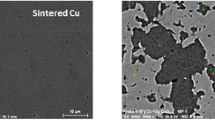Abstract
A direct current glow discharge mass spectrometer has been used to analyse solid non-conducting samples: glass, polycarbonate, marble, aluminium oxide and Teflon. This is made possible by the use of a so-called secondary cathode. The methodology of this concept is investigated and analytical figures of merit are presented.
Similar content being viewed by others
Author information
Authors and Affiliations
Rights and permissions
About this article
Cite this article
Schelles, W., De Gendt, S., Maes, K. et al. The use of a secondary cathode to analyse solid non-conducting samples with direct current glow discharge mass spectrometry: potential and restrictions. Fresenius J Anal Chem 355, 858–860 (1996). https://doi.org/10.1007/s0021663550858
Received:
Accepted:
Issue Date:
DOI: https://doi.org/10.1007/s0021663550858




